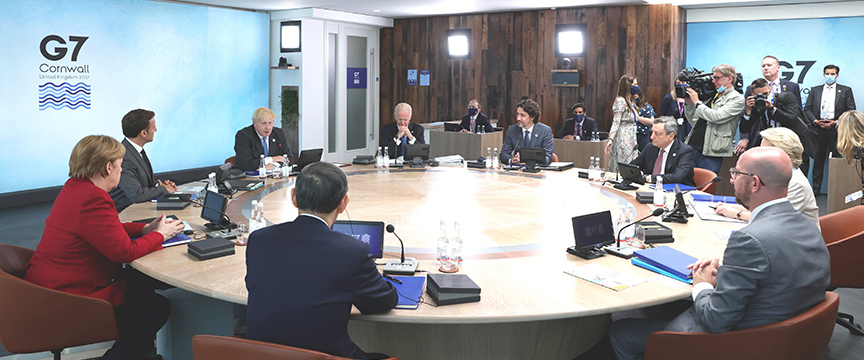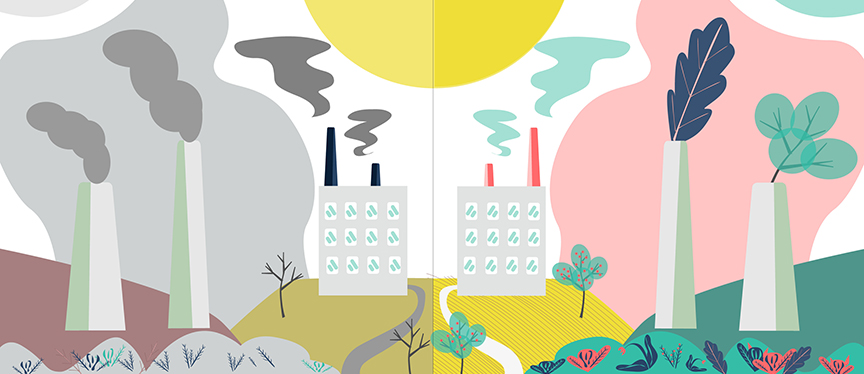It’s All About Balance in a Net-Zero World
14 June 2021
Net zero seems to be the hot new phrase. Companies and countries are pledging to be “net zero,” several by 2050; China by 2060.
You can buy a carbon neutral car. Microsoft aims for carbon negativity by 2030. The G7 Environment and Climate Ministers pledged to be net zero by 2050. A survey of 4,000 “significant entities” – major countries, companies, and cities – found 61% have committed to net zero. The G7 committed to achieve net zero by 2050, a new commitment for the super group of countries that reiterates their agreement in the Paris Agreement.
The Race to Zero, as the UK Climate COP26 Presidency puts it, is on.
This idea of balance – cancelling out our bad actions with good actions – appears across environmental governance. Human impact on the environment is significant and growing. New phrases have emerged to describe these impacts: climate emergency, nature crisis, the Anthropocene. Our growing impact brings new urgency and complexity to achieving a balance with nature.
Let’s consider how net zero has appeared in climate and energy governance, and other areas like desertification and biodiversity. These instances of striving for balance raise similar questions: is balance about cancelling out the bad with the good? Or is it about reducing the bad to be in line with the good? In the answers may lie the future of the planet.

Net Zero by Another Name?
The Paris Agreement sets a goal “to achieve a balance” between anthropogenic emissions and removals by carbon sinks by 2050. Many interpreted this as code for net zero, carefully crafted through negotiations to find a phrase all parties could agree with.
But the roadmap to achieve this lofty goal may stumble if left to the consensus of almost 200 UN Member countries. While the International Energy Agency’s “Net Zero by 2050” report lays out a pathway with 400+ milestones, challenges may lie ahead on the path to the High-Level Dialogue on Energy. Technical discussions to prepare the inputs to the High-Level Dialogue included questions on whether to refer to the 2050 net-zero objective. The Ministerial Thematic Forums, taking place from 21-25 June 2021, will show where the global consensus stands.
A similar debate took place in the context of desertification. The original proposal was “Net Zero Land Degradation.” But, the Rio+20 Declaration “The Future We Want” showed countries’ preference for the idea of neutrality, “to strive to achieve a land-degradation neutral world in the context of sustainable development.” Land-degradation neutrality (LDN) was later enshrined in SDG 15.3: By 2030, combat desertification, restore degraded land and soil, including land affected by desertification, drought and floods, and strive to achieve a land degradation-neutral world. So far, 127 countries have set LDN Targets under the LDN Target Setting Programme.
The Convention on Biological Diversity (so far) bucks this preference for balance or neutrality. Current work toward the post-2020 global biodiversity framework includes references to “no net loss” for freshwater, marine, and terrestrial ecosystems. The non-paper recently developed by the contact group on goals has [no net loss], the square brackets signaling not all parties agree to the phrase’s inclusion. Watch this space.

Zero Tolerance
Does it matter if it’s called net zero or carbon neutrality / land degradation neutrality / no net loss? Well, maybe not. We could be splitting hairs. After all, there is no definition of net zero. It’s meant to refer to balancing emissions (in the climate case) with removals of emissions, perhaps through planting forests or carbon removal technologies.
This might be necessary for some industries. Energy production can be reduced significantly by moving to renewable energy. Transportation could run on clean electricity. Homes could be insulated and run through solar panels. But aviation, for example, has fewer alternatives to burning fossil fuels. Technologies or trees could help them balance their negative impacts.
Agriculture is on all sides of the balancing act. The sector may need to use some sort of offset to counteract its emissions or contribution to land degradation. But many countries seek to improve agricultural practices as part of land degradation targets, improving the quality of agricultural lands to balance losses elsewhere.
There may be an important nuance. Balance can mean many things. Think of a children’s seesaw: two adults would balance the seesaw; two children would as well. Large emissions could balance with large sinks; significant land degradation offset with significant restoration elsewhere. (Perhaps relevant in this context: G7 countries have injected USD 190 billion into fossil fuels as part of Covid-19 recovery packages.) Or, damage could be abated, reduced to a level where fewer counteracting measures would be needed - the children in the analogy, and much easier to balance without wild swings on the seesaw.
Therein lies the danger of “balance”: the status quo of growing emissions, land degradation, and ecosystem loss could continue so long as the offending parties planted enough trees. Boiled down, many of the questions about balance are about ensuring “like for like” - that the solution is as permanent and impactful as the damage caused. Below the surface talk of balance, neutrality, and net zero lie several problems that could make the ideas unworkable in practice or undermine environmental integrity.

Net Zero Quality Over Quantity
So far a lot of the net zero – er, balance or neutrality – discussions have focused on quantity. Plans should remove the same amount of greenhouse gases as emitted. The amount of land resources should remain stable or increase. But, as the UN Convention to Combat Desertification is quick to add: quality matters.
Land is zero sum, but not all lands are equally productive or healthy. The expected loss of productive land cannot be undone or balanced with the preservation of degraded land. To count, those lands have to be restored to a healthy state able to help support nature and people. A review of LDN targets revealed many countries had not systematically analyzed the causes and effects of land degradation before setting a target. Many had not linked their LDN targets to climate change, even though similar sectors are involved. Whether energy or land, all eyes are on forests to help us right our wrongs.
Similarly for climate, quality matters. Not all pledges or greenhouse gases are equal. The Race to Zero Campaign has set out four minimum criteria: pledge something fair by 2050; plan how to meet that pledge; proceed with the plan; and publish your results. So far, 20% of net zero pledges meet these minimum criteria. Importantly, the EU, China, the US, and Japan are on that list. The UN Secretary-General is calling for clear and credible plans to meet net zero pledges, because long-term targets are near-pointless without interim plans and goals.
Many other questions remain unanswered. Many net zero pledges may seek to buy credits from developing countries to balance their emissions on paper (rarely do the pledgers explicitly state how they will reach net zero). Offsetting presents a whole range of additional, potential problems. Only a few entities have set conditions for these credits. Corporate pledges vary widely in the details. Meanwhile, people’s lives, livelihoods, and human rights may be affected by the decisions made regarding lands, forests, and technologies. The Clean Development Mechanism, a central climate offset mechanism, has been linked to human rights abuses, prompting calls in modern “Article 6” mechanisms on carbon credit and offset mechanisms to include strong safeguards to protect the rights of Indigenous Peoples and local communities.
Permanence is another central question for net zero to deliver real results. After all, to balance emissions or land degradation that will last for hundreds of years, the removals must be likewise long lasting. For example, forest fires emit CO2 and can reverse improvements in land quality. Or, will the emissions offset or reduction be permanent enough? Much may depend on what substances will net zero apply to. Some greenhouse gases cause damage for hundreds of years; others have more impact, over a shorter time. The EU includes all gases, China CO2 only, and the US has yet to specify. And those net negative pledges? Microsoft’s historic emissions have been causing problems in the atmosphere for years; a one-to-one offset may be net zero in only the technical sense.
Similarly, are the actions “additional” to what would’ve happened anyway; a removal is only a removal if it absorbs emissions that wouldn’t have been absorbed without the added investment from the carbon market or through a regulatory mechanism. Otherwise, it is a reduction on paper only.
Where to From Here?
The idea of net zero or neutrality target setting has pushed action. Credit rating giant Moody’s predicts a coming credit crunch for carbon-intensive industries because of the rise of net-zero pledges and push for greater transparency. Of course, this will only materialize if companies and countries actually attempt to balance their effect on the atmosphere and nature. Promises have been made and ignored before. The idea is there, and popular. What’s next is making the plans to achieve balance credibly, and urgently.
This article was originally distributed in the Earth Negotiations Bulletin Linkages Update enewsletter and was written by Dr. Jennifer Allan and Dr. Lynn Wagner.